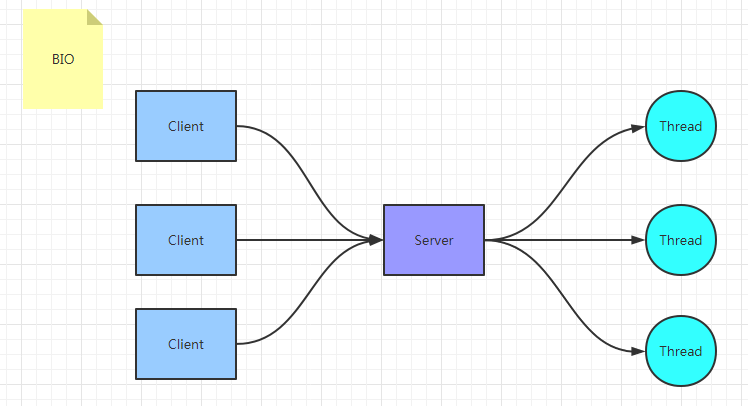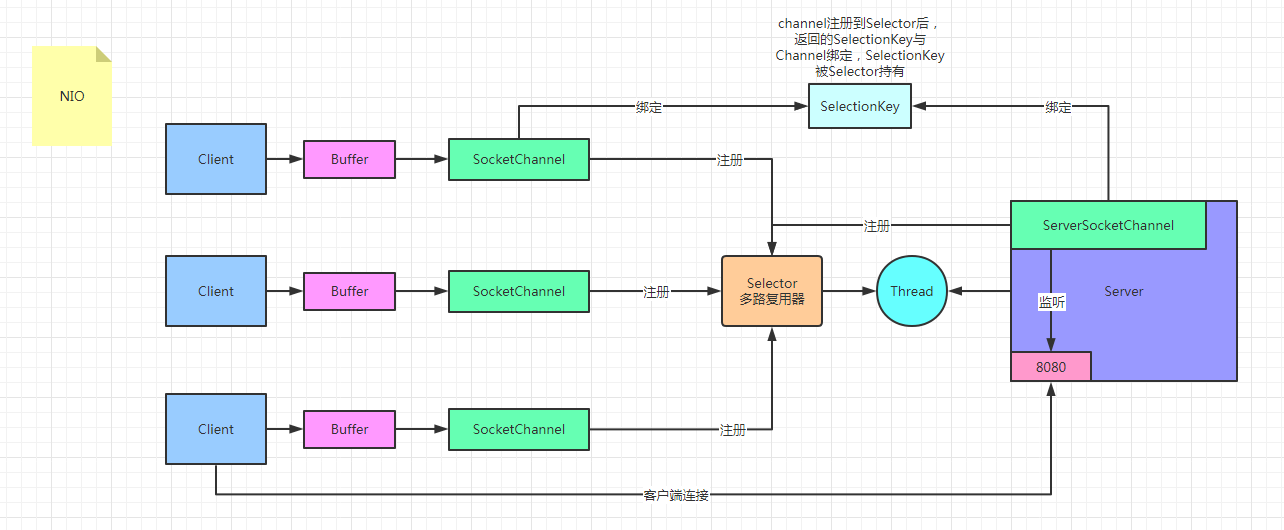BIO
同步阻塞模型, 一个客户端连接对应一个处理线程
缺点
- IO代码里read操作是阻塞操作,如果连接不做数据读写操作会导致线程阻塞,浪费资源
- 如果线程很多,会导致服务器线程太多,压力太大
应用场景
BIO 方式适用于连接数目比较小且固定的架构, 这种方式对服务器资源要求比较高, 但程序简单易理解
图解

代码
- Server
public class BIOServer {
public static void main(String[] args) throws IOException {
ServerSocket serverSocket = new ServerSocket(8080);
for (;;){
System.out.println("等待客户端连接....");
//此处阻塞
Socket socket = serverSocket.accept();
System.out.println("有客户端连接了");
byte[] bytes = new byte[1024];
//此处阻塞
int len = socket.getInputStream().read(bytes);
if (len != -1)
System.out.println("接收到客户端的信息:" + new String(bytes, 0, len));
System.out.println("向客户端发送一条信息...");
socket.getOutputStream().write("Hello Client".getBytes());
socket.getOutputStream().flush();
System.out.println("信息已发送");
socket.close();
}
}
}
- Client
public class BIOClient {
public static void main(String[] args) throws IOException {
Socket socket = new Socket("127.0.0.1", 8080);
System.out.println("准备向服务端发送信息....");
socket.getOutputStream().write("Hello Server".getBytes());
socket.getOutputStream().flush();
System.out.println("信息发送完毕");
byte[] bytes = new byte[1024];
//此处阻塞
int len = socket.getInputStream().read(bytes);
if (len != -1)
System.out.println("接收到服务端返回的信息:" + new String(bytes, 0, len));
socket.close();
System.out.println("连接结束");
}
}
NIO
同步非阻塞,服务器实现模式为一个线程可以处理多个请求(连接),客户端发送的连接请求都会注册到多路复用器selector上,多路复用器轮询到连接有IO请求就进行处理。
I/O多路复用底层一般用的Linux API(select,poll,epoll)来实现,他们的区别如下表:
| select | poll | epoll(JDK 1.5及以上) | |
|---|---|---|---|
| 操作方式 | 遍历 | 遍历 | 回调 |
| 底层实现 | 数组 | 链表 | 哈希表 |
| IO效率 | 线性遍历 O(n) | 线性遍历 O(n) | 事件通知方式O(1) |
| 最大连接 | 有上限 | 无上限 | 无上限 |
IO效率
- select: 每次调用都进行线性遍历,时间复杂度为O(n)
- poll: 每次调用都进行线性遍历,时间复杂度为O(n)
- epoll:事件通知方式,每当有IO事件就绪,系统注册的回调函数就会被调用,时间复杂度O(1)
应用场景:
NIO方式适用于连接数目多且连接比较短(轻操作) 的架构, 比如聊天服务器, 弹幕系统, 服务器间通讯,编程比较复杂, JDK1.4 开始支持
NIO 有三大核心组件: Channel(通道), Buffer(缓冲区),Selector(选择器)
图解

1、channel 类似于流,每个 channel 对应一个 buffer缓冲区,buffer 底层就是个数组
2、channel 会注册到 selector 上,由 selector 根据 channel 读写事件的发生将其交由某个空闲的线程处理
3、selector 可以对应一个或多个线程
4、NIO 的 Buffer 和 channel 都是既可以读也可以写
代码
- Server
public class NIOServer {
public static void main(String[] args) throws IOException {
ServerSocketChannel serverSocketChannel = ServerSocketChannel.open();
//配置为非阻塞模式
serverSocketChannel.configureBlocking(false);
serverSocketChannel.socket().bind(new InetSocketAddress(8080));
//创建一个多路复用器selector
Selector selector = Selector.open();
//将ServerSocketChannel注册到selector上,并且设置selector对客户端连接感兴趣
serverSocketChannel.register(selector, SelectionKey.OP_ACCEPT);
for(;;){
System.out.println("等待事件发生....");
//轮询selector的key,此处阻塞
selector.select();
System.out.println("有事件发生了");
Iterator<SelectionKey> iterator = selector.selectedKeys().iterator();
while (iterator.hasNext()) {
SelectionKey selectionKey = iterator.next();
//删除本次已处理的key,防止下次select重复处理
iterator.remove();
handle(selectionKey);
}
}
}
public static void handle(SelectionKey selectionKey) throws IOException {
if(selectionKey.isAcceptable()){
System.out.println("有客户端连接事件发生了");
//由于此处为对accept感兴趣,只有ServerSocketChannel注册到selector上时是对accept感兴趣,
//所以这里的channel是ServerSocketChannel
ServerSocketChannel serverSocketChannel = (ServerSocketChannel) selectionKey.channel();
//NIO非阻塞体现:此处accept方法是阻塞的,但是这里因为是发生了连接事件,所以这个方法会马上执行完,不会阻塞
SocketChannel socketChannel = serverSocketChannel.accept();//同BIO返回一个连接客户端的channel(socket)
//将SocketChannel配置为非阻塞,并且对read事件感兴趣
socketChannel.configureBlocking(false);
socketChannel.register(selectionKey.selector(), SelectionKey.OP_READ);
}else if(selectionKey.isReadable()){
System.out.println("有客户端数据可读事件发生了");
//由于此处为对read感兴趣,只有SocketChannel注册到selector上时是对read感兴趣
//所以这里的channel是SocketChannel
SocketChannel channel = (SocketChannel) selectionKey.channel();
//以下为读取客户端发送的数据与向客户端发送数据操作
ByteBuffer byteBuffer = ByteBuffer.allocate(1024);
//NIO非阻塞体现:首先read方法不会阻塞,其次这种事件响应模型,当调用到read方法时肯定是发生了客户端发送数据的事件
int len = channel.read(byteBuffer);
if(len != -1)
System.out.println("接收到客户端的数据:" + new String(byteBuffer.array(), 0, len));
ByteBuffer bufferToWrite = ByteBuffer.wrap("Hello Client".getBytes());
channel.write(bufferToWrite);
}
}
}
- Client
public class NIOClient {
public static void main(String[] args) throws IOException {
SocketChannel socketChannel = SocketChannel.open();
socketChannel.configureBlocking(false);
Selector selector = Selector.open();
//此时客户端注册到selector,并且是对connect感兴趣
socketChannel.register(selector, SelectionKey.OP_CONNECT);
// 客户端连接服务器,其实方法执行并没有实现连接,需要调用channel.finishConnect()才能完成连接
socketChannel.connect(new InetSocketAddress("127.0.0.1",8080));
while (true){
selector.select();
Iterator<SelectionKey> iterator = selector.selectedKeys().iterator();
while (iterator.hasNext()) {
SelectionKey selectionKey = iterator.next();
iterator.remove();
if(selectionKey.isConnectable()){
SocketChannel channel = (SocketChannel) selectionKey.channel();
// 如果正在连接,则完成连接
if (channel.isConnectionPending()) {
channel.finishConnect();
}
ByteBuffer bufferToWrite = ByteBuffer.wrap("Hello Server".getBytes());
channel.write(bufferToWrite);
channel.configureBlocking(false);
channel.register(selector, SelectionKey.OP_READ);
}else if(selectionKey.isReadable()){
SocketChannel channel = (SocketChannel) selectionKey.channel();
ByteBuffer byteBuffer = ByteBuffer.allocate(1024);
int len = channel.read(byteBuffer);
if(len != -1)
System.out.println("接收到服务端的数据:" + new String(byteBuffer.array(), 0, len));
}
}
}
}
}
AIO
异步非阻塞, 由操作系统完成后回调通知服务端程序启动线程去处理。
应用场景:
AIO方式适用于连接数目多且连接比较长(重操作) 的架构,JDK7 开始支持
代码
- Server
public class AIOServer {
public static void main(String[] args) throws IOException, InterruptedException {
final AsynchronousServerSocketChannel serverChannel =
AsynchronousServerSocketChannel.open().bind(new InetSocketAddress(9000));
serverChannel.accept(null, new CompletionHandler<AsynchronousSocketChannel, Object>() {
@Override
public void completed(AsynchronousSocketChannel socketChannel, Object attachment) {
try {
// 再此接收客户端连接,如果不写这行代码后面的客户端连接不上服务端
serverChannel.accept(attachment, this);
System.out.println(socketChannel.getRemoteAddress());
ByteBuffer buffer = ByteBuffer.allocate(1024);
socketChannel.read(buffer, buffer, new CompletionHandler<Integer, ByteBuffer>() {
@Override
public void completed(Integer result, ByteBuffer buffer) {
buffer.flip();
System.out.println(new String(buffer.array(), 0, result));
socketChannel.write(ByteBuffer.wrap("HelloClient".getBytes()));
}
@Override
public void failed(Throwable exc, ByteBuffer buffer) {
exc.printStackTrace();
}
});
} catch (IOException e) {
e.printStackTrace();
}
}
@Override
public void failed(Throwable exc, Object attachment) {
exc.printStackTrace();
}
});
Thread.sleep(Integer.MAX_VALUE);
}
}
- Client
public class AIOClient {
public static void main(String... args) throws Exception {
AsynchronousSocketChannel socketChannel = AsynchronousSocketChannel.open();
socketChannel.connect(new InetSocketAddress("127.0.0.1", 9000)).get();
socketChannel.write(ByteBuffer.wrap("HelloServer".getBytes()));
ByteBuffer buffer = ByteBuffer.allocate(512);
Integer len = socketChannel.read(buffer).get();
if (len != -1) {
System.out.println("客户端收到信息:" + new String(buffer.array(), 0, len));
}
}
}
BIO&NIO&AIO对比
| BIO | NIO | AIO | |
|---|---|---|---|
| IO模型 | 同步阻塞 | 同步非阻塞 | 异步非阻塞 |
| 编程难度 | 简单 | 复杂 | 复杂 |
| 可靠性 | 差 | 好 | 好 |
| 吞吐量 | 低 | 高 | 高 |
